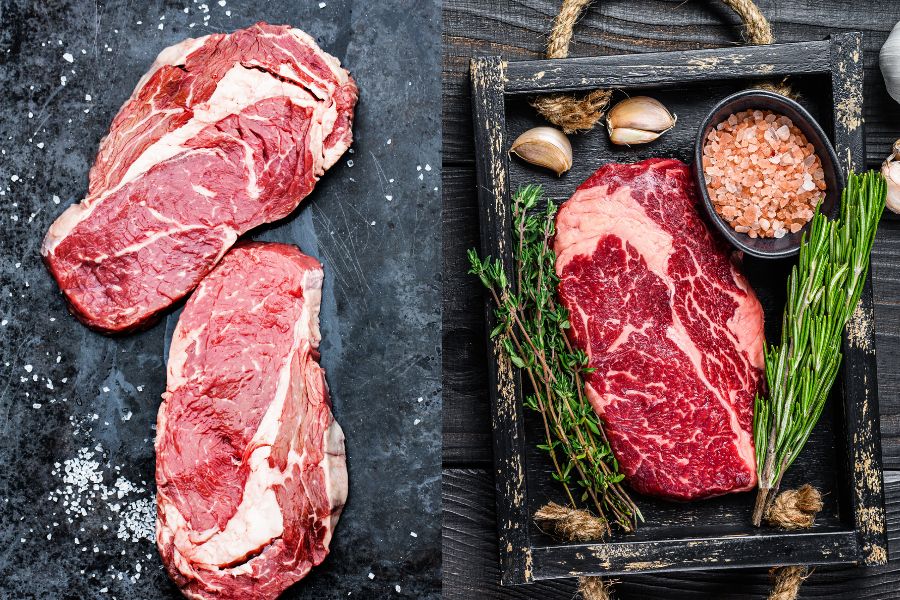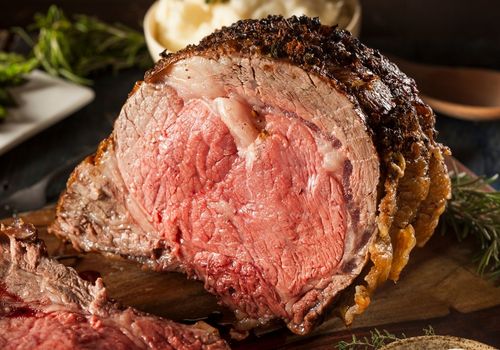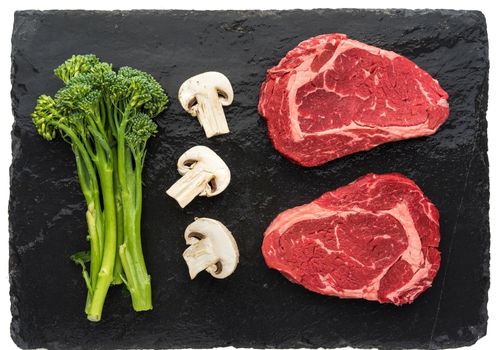Both the prime ribs and the ribeye are flavorful steak cuts because of where they’re taken from (along the cow’s ribs). However, the prime rib is considered a little more flavorful because of the higher fat content and the rib bones. And guess what? It’s cheaper than the ribeye!
I’ve had a lot of beef enthusiasts and readers who have sent in messages requesting information about the ribeye and prime rib cuts of meat. They want to understand where the meat comes from, its uses, the difference between prime rib vs. ribeye taste, meat quality, and cost.
In today’s prime rib vs. ribeye article, I will cover all this and more. So, if you’re unsure about what prime rib and the rib eye steaks are, keep reading!

Don’t get carried away. There’s not much of a difference between the ribeye steak and the prime rib steak. One of the minimal differences is the method of preparation.
Prime rib is a primal cut of beef. In other words, the prime rib is one of the first cuts of the animal.
The ribeye is the center muscle of that cut. Prime rib has the ribeye but the ribeye is not prime rib. Oh, and USDA prime grade is something else entirely. It’s a quality grade selection and not a cut.
In price terms, there’s not much difference. I got a ribeye cut for around $14 per pound from the Chicago Steak Company. Meanwhile, prime rib cuts of meat sell for around $13 to $17, depending on the grade of the meat at the local butcher.
Related Reading
I have been a chef for decades and a meat slicer at grocery stores as well. I’ve been cutting rib steaks from the same beef primal for making rib prime roast.
Trust me when I tell you that prime rib roasts and prime ribeyes are almost the same primal cuts.
Bone-in cut is used to roast standing ribs. It’s cut on the rib bone for a cowboy-cut steak.
Meanwhile, a boneless prime rib roast is also used to cut boneless ribeye steaks.
A ribeye primal comprises the longissimus dorsi muscle but also contains the complexus and spinalis muscles. The spinalis dorsi, or ribeye/rib cap is the tastiest meat from a cow. However, it is rarely cut as a single steak because it ends up with the primal like ribeye steak or prime rib roast.
Also, when you see a rib on a restaurant menu, it’s almost always a portion of meat taken from a cooked roast held at serving temperature.
A ribeye is almost always a raw steak cut prepared to the doneness requested at the time of the order.

In my personal experience, one of the main differences is a matter of how it’s generally cooked.
If it’s a roast, the meat is placed in a pan, and heated. You can also grill them on each side for a couple of minutes and then cook them indirectly to get a perfect medium rare. With this method, you’ll get a brown meat crust at the back and a medium rare on the inside.
What if the bones were removed? Then the roast is braised. It can also be seasoned and placed in a pan (the same side down).
Since there are no ribs to keep it off the bottom of the pan, a rack is usually put on the pan or cast iron skillet and then given a pan searing.
The meats use the same parts of the beef, the same seasoning, the same oven, and similar cooking process, but give two different results. You would get a very good “carne asada” from the boneless rib.
It’s also wonderful when there’s horseradish near the diner’s plate. I know some people love Au Jus, and that’s fine too.
People have told me that “the difference between the bone and the flavor of the bones” is imaginary when it comes to beef, whether in a roast or a steak like a bone-in ribeye or on both sides of a porterhouse.
I can usually tell the difference between the bite of a steak and a strip made on the same grill by the same cook.
Sometimes, you’ll hear the ribeye referred to as a Delmonico Steak (borrowed from a restaurant with the same name in New York), and is cut from Prime’s rib.
The rib can also be called a rib eye. Confused? A Choice Beef Rib is technically not a “prime” rib.
The steak can be prepared whole or boneless, and generally without any fat: grilled, smoked, or even baked. The gastronomic reason why the bone is sometimes left attached to the meat when cooking is that the moisture and fat located next to the bone improve the flavour.
In some cases, a piece of fat extracted from the cut of steak that’s going to be roasted is used as fat on the previously heated stone or griddle.
It’s the equivalent of grilled meat without added fat since the fat used on the grill comes from the cut of meat itself.
Whether you choose one or the other, you will thoroughly enjoy the end result. It is hard to mess up a prime rib cut if you cook it. If you’re cooking a one-inch steak and you want it medium, you’ll have to cook it for about six minutes and four minutes on 400 degrees on a grill.
Related Reading
I’m starting with the most flavorful of all premium steaks – the ribeye steak. The reason it’s called an “eye” is because once the rib bone is removed, what’s left is somewhat oval.
When the ribs are removed from the rib primal section, the part is called the rib eye, i.e., the “eye” of the cut.
Whole or cut into fillets, the ribeye is one of the most popular, juicy and expensive cuts of meat on the market. The meat from the section near the rib is softer and fattier than most cuts of beef and in some cases may have white streaks of fat mixed with muscle tissue.
The meat is then said to have marbling. This additional fat makes the beef rib a particularly tender piece of roast meat with a pleasant flavor and can be well-adapted to dry heat cooking.
You could get a standing rib roast from the ribeye. Similarly, you can also get what we call the cowboy steak.
This is for people who really love a big steak. Many customers will buy one and share it. However, there are two types of ribeyes – the bone-in rib eye and the boneless ribeye steak. They are the same pieces of meat.
The difference here being that the bone is left on in one, and the bone is removed from the other one. On the boneless, we get ribeye steaks, and prime rib roast.
Prime rib roast and standing rib roast are the same pieces of meat. One has a bone, and one doesn’t. The cost is just about the same. There’s very little difference.
Related Reading

The prime rib is a large roasting joint with a large rib bone section. The rib bones of these cuts are usually curved. This is what creates the natural roasting rack.
Prime rib is actually one of the most confusing names in the meat world, and here’s why. They aren’t usually USDA prime ribs. It’s just a name used to refer to any roast or steak taken from any of the ribs just before the loin.
We have USDA grades like choice, prime and select, which refers to the quality of the meat. However, you can have select-grade prime rib.
The reason why it’s called prime rib is because this meat cut is taken from the primal rib. You would also be right also if you think it’s called prime rib because it’s a quality rib.
In any case, the main thing you’re looking for in a proper prime rib cut is the little intramuscular seams of fat found in the muscle itself. It’s the last type of fat to form. What it means for your steak is that it’s going to be more tender and flavorful because fat is a vehicle for flavor.
Finally, the prime rib is typically roasted slowly until it measures around 130°F and 140°F when you test it with a meat thermometer.
Related Reading
Although the prime rib and the rib eye steak are not the same, there’s not a lot of difference. They come from the same primal beef cut. The difference between the prime rib and ribeye is that the ribs are removed from the cut for a ribeye.
Although they’re from the same part of the cow, the prime rib is cheaper because dining establishments can get larger meat cuts with prime ribs. Large prime ribs are sold cheaper per pound compared to the same cut from the rib eye.
As mentioned, the prime rib is considered a little more flavorful because of the higher fat content and bones along this cut of meat. However, as you can guess, the prime rib is more expensive.
In the end, the “difference” between the two comes down to the quality of the meat and what the cook does with it. Remember, the ribeye is probably the most flavorful of all premium steaks.
However, if both the prime rib and ribeye are good quality, the results are often great. They can be easily cooked as well. You don’t need to marinate them as they are high-quality cuts of meat.
You can eat them using a fork and knife, so when I say that they’re the most flavorful, they’re also very tender.